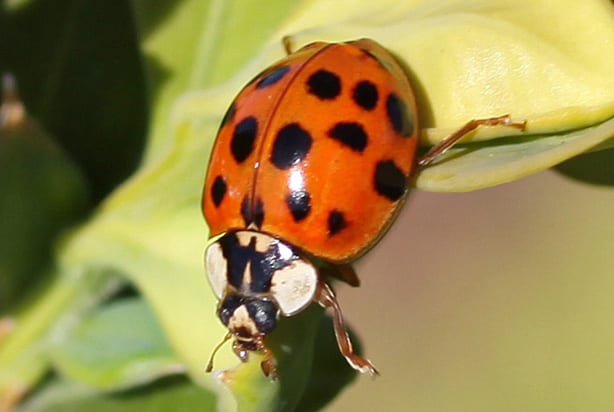Submitted by Faye Mahaffey
OSUE Brown County Master Gardener Volunteer
After the freezing temperatures this weekend, the plants on the deck were finished off and put out of their misery. I brought some catnip in for Miss Kitty but decided to leave the Rosemary plant outside. I have 5 houseplants in the sunroom (one of which is Oat grass for Miss Kitty) and I don’t plan on having any more!
Have you noticed any new “bugs” buzzing around inside? Last week, I kept getting dive-bombed while I was working in the garden by Asian Ladybugs. How do I know? Because I made the serious mistake of smashing one on my arm and the smell was the best clue!
According to Ohioline Factsheet ENT-44, Lady beetles, which are sometimes called ladybugs or lady bird beetles, are familiar insects in many parts of the United States. Lady beetles generally are beneficial predators that consume aphids, scale insects, and many other pests that injure plants in our garden, landscapes, and agricultural settings. In 1975, the “Ladybug” became Ohio’s official state insect by resolution of the Ohio General Assembly.
The multicolored Asian lady beetle (MALB) is native to Asia, where it is an important predator that feeds on aphids and other soft-bodied insects that dwell in trees. It is well documented that MA LB was intentionally imported from Russia, Japan, Korea, and elsewhere in the Orient and released in a number of U.S. states and Nova Scotia, Canada, as part of USDA biological control programs to manage insect pests of trees.
MALB was recognized in Ohio in October 1993, when some residents reported that thousands of lady beetles were congregating on homes and buildings, with many of these insects finding their way indoors.
The MALB life cycle from egg to adult requires about a month or so, depending on the weather and food supply. Thus, there are multiple generations per season in Ohio.
An important feature used to distinguish MA LB from other lady beetles found in Ohio, including native species, is the appearance on the white pronotum (top covering of middle body part) of a black regularly to irregularly shaped “M” or “W”, depending upon whether the beetle is viewed from the front or from the rear.
The MALB has several bad habits. Their negative behavior and impacts can be separated into four general categories: interior pest; outdoor nuisance pest; fruit and fruit products pest; and competitor to other predators including native lady beetles.
When lady beetles are disturbed, they defend themselves by exuding a yellow-orange body fluid, which is their blood. Research has shown that MALB’s defense blend is one of the most powerful deterrents against predators that is found in all lady beetles. The blood has a foul odor and can permanently stain walls, drapes, carpeting, etc.
An effective way to quickly collect and dispose of large numbers of MALB in a home is to use a “fan-bypass” vacuum cleaner (e.g., shop-vac). This type of vacuum cleaner has the vacuum impeller (fan) positioned after a collection container or bag; refuse is collected in the bag or container without passing through the impeller. I just wish my shop vac wasn’t so loud!
Want to learn more about MALB? Go to the OSU Ohioline website and search for factsheet ENT-44.
I finally finished up in the garden. I didn’t want to gaze down at all the weeds for the entire winter. It’s time for me to sit down and start designing my raised beds that we are building in the spring. Hopefully that will help in the battle against the weeds!
